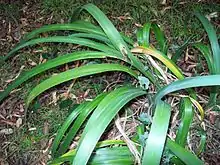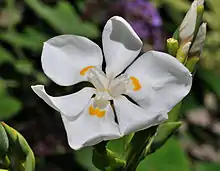Dietes robinsoniana
Dietes robinsoniana, the Lord Howe wedding lily, is found naturally only on Lord Howe Island.[2] It grows on cliff faces, often in exposed situations. Found also on forest margins and the tops of Mount Gower and Mount Lidgbird and behind the beaches on Lord Howe Island. It is one of the world's most intriguing and remarkable biogeographic disjunctions, with its nearest phylogenetic relatives occurring in Africa.[3]
| Dietes robinsoniana | |
|---|---|
 | |
| Scientific classification | |
| Kingdom: | Plantae |
| Clade: | Tracheophytes |
| Clade: | Angiosperms |
| Clade: | Monocots |
| Order: | Asparagales |
| Family: | Iridaceae |
| Genus: | Dietes |
| Species: | D. robinsoniana |
| Binomial name | |
| Dietes robinsoniana | |
| Synonyms[1] | |
This is the largest plant in the genus Dietes. It does not tolerate cold temperatures.[4]

An uncommon plant, though it may be locally abundant in certain sites. Growing up to 1.5 metres tall, the leaves are sword-shaped or linear, 4 to 7 cm wide. Flowering occurs from September to December. The flowers are white with yellow, lasting for one day only.
Flat triangular seeds form in a roundish shaped capsule, 3 to 4 cm long. The black seeds are around 10 mm long.
References
- Kew World Checklist of Selected Plant Families
- "Dietes robinsoniana". PlantNET - NSW Flora Online.
- Peter Goldblatt (1981), "Systematics, Phylogeny and Evolution of Dietes (Iridaceae)", Annals of the Missouri Botanical Garden, 68 (1): 132–153, doi:10.2307/2398817, JSTOR 2398817
- Cundall. P., (2008) Native Plants:The definitive guide to Australian plants, Global Book Publishing Lane Cove, N.S.W, page 65, ISBN 978-1-74048-027-7
| Wikimedia Commons has media related to Dietes robinsoniana. |
| Wikispecies has information related to Dietes robinsoniana. |